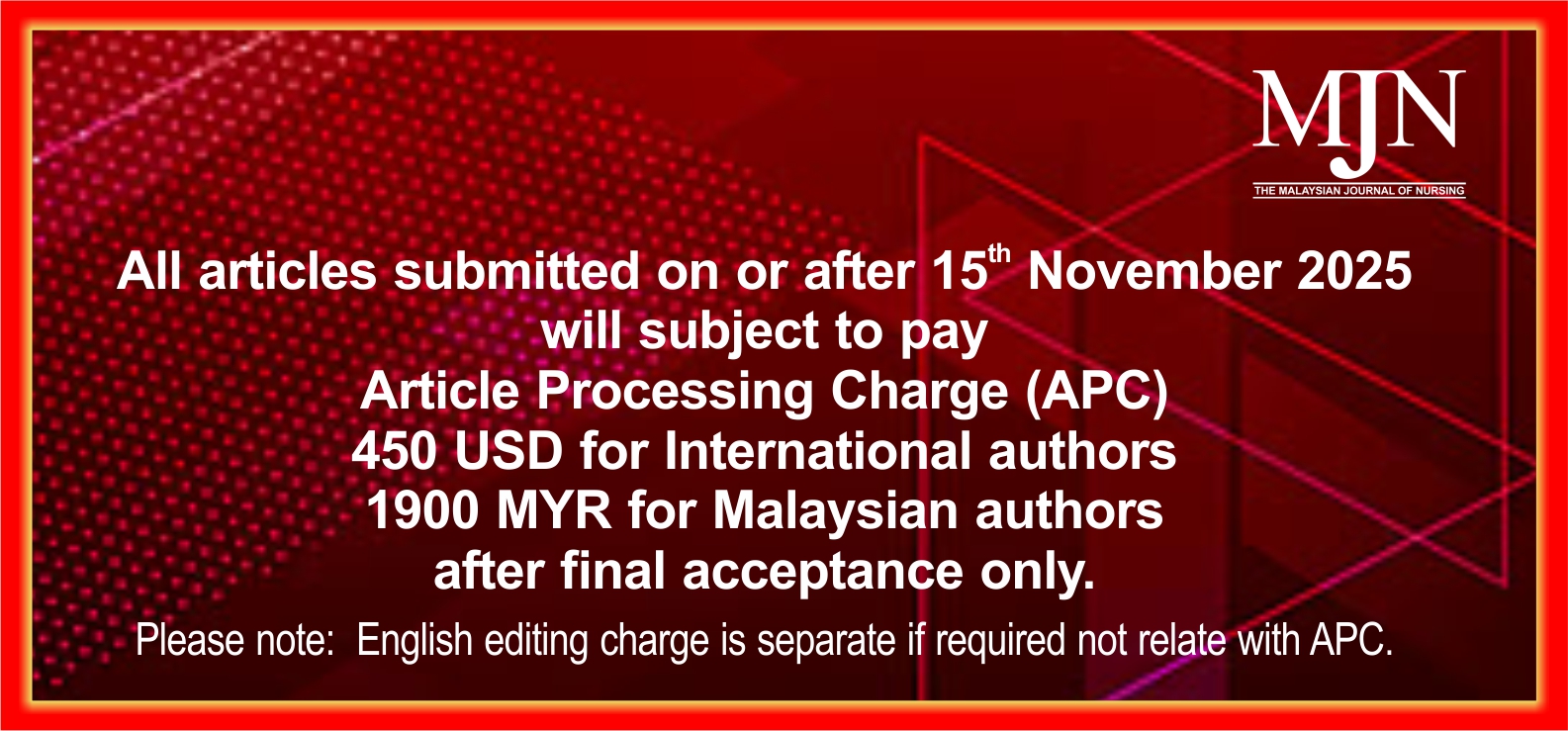Paracetamol as Analgesia Following Spontaneous Vaginal Delivery: Reappraisal of Practice
DOI:
https://doi.org/10.31674/mjn.2023.v14i03.001Abstract
Background: We aim to determine the prevalence of perineal pain following postpartum vaginal delivery, the requirement of paracetamol as analgesia, and its associated factors.
Methods: The study was performed from December 14, 2020, until February 14, 2021, in a single tertiary centre in northwest Malaysia. The pain score was assessed immediately postpartum and every six hours for the next 48 hours, and the requirement for paracetamol as analgesia was documented. Maternal sociodemographic data and baseline clinical details associated with the requirement for paracetamol were analysed.
Results: A total of 285 study participants were included. The majority (93.0%) were Malays, with a mean age of 31.0 6.08 years. Majority of the women delivered their second child (36.1%) with a first-degree tear (46.7%). The majority neither required any analgesia within the first few hours of delivery in the labour room (71.3%) nor in the next 48 hours of ward observation (54.4%). The mean pain score following spontaneous vaginal delivery in the labour room was 4.0 1.07, while the mean pain score in the ward was 2.8 ± 1.05 (p<0.001). Logistic regression analysis determined that maternal weight (cOR: 1.02, 95% CI: 1.01, 1.04) and episiotomy (cOR: 3.28, 95% CI: 1.52, 7.08) were significantly predictive of paracetamol requirement as analgesia.
Conclusion: Most of our population did not require oral analgesia in the postpartum period. However, the identification of susceptible individuals may guide clinicians to have a targeted approach for early management to ensure a positive birthing experience for all mothers.
Keywords:
Analgesia, Obstetrical, Postpartum Period, Prevalence, Episiotomy, Acetaminophen, Logistic ModelsDownloads
References
Abdel Shaheed, C., Ferreira, G. E., Dmitritchenko, A., McLachlan, A. J., Day, R. O., Saragiotto, B., ... & Maher, C. G. (2021). The efficacy and safety of paracetamol for pain relief: an overview of systematic reviews. Medical Journal of Australia, 214(7), 324-331. https://doi.org/10.5694/mja2.50992
Abdraboo, R. A., Amasha, H. A.-R., & Ali, S. E. (2020). Effectiveness of Inhalation of Lavender Oil in Relievng Post-cesarian Section Pain. The Malaysian Journal of Nursing (MJN), 12(1), 113–122. https://doi.org/10.31674/MJN.2020.V12I01.014
Amasha, H., Abdel-Haleem, S., & Gamal, A. (2020). Assessing the Competence of Nurses in Rendering Postpartum Care and Its Effect on Women’s Satisfaction. The Malaysian Journal of Nursing (MJN), 11(4), 99–110. https://doi.org/10.31674/MJN.2020.V11I04.011
Aworinde, O. (2021). Oral Paracetamol versus oral Diclofenac in the control of uterine cramping pain after vaginal birth. Ethiopian Medical Journal, 59(04).
Basem, J. I., White, R. S., Chen, S. A., Mauer, E., Steinkamp, M. L., Inturrisi, C. E., & Witkin, L. R. (2021). The effect of obesity on pain severity and pain interference. Pain Management, 11(5), 571–581. https://doi.org/10.2217/pmt-2020-0089
Chou, D., Abalos, E., Gyte, G. M. L., & Gülmezoglu, A. M. (2013, January 31). Paracetamol/acetaminophen (single administration) for perineal pain in the early postpartum period. Cochrane Database of Systematic Reviews. John Wiley and Sons Ltd. https://doi.org/10.1002/14651858.CD008407.pub2
Colleen Stainton, M., Edwards, S., Jones, B., & Switonski, C. (2005). The Nature of Maternal Postnatal Pain. Journal of Perinatal Education, 8(2), 1–10. https://doi.org/10.1624/105812499x87060
Dwi Putri, A. (2019). The Relationship of Early Breastfeeding Initiation with Postpartum Maternal Prolactin Levels. Malaysian Journal of Medical Research, 03(01), 5–9. https://doi.org/10.31674/mjmr.2019.v03i01.002
Elmallah, R. K., Ramkumar, P. N., Khlopas, A., Ramkumar, R. R., Chughtai, M., Sodhi, N., ... & Mont, M. A. (2018). Postoperative pain and analgesia: is there a genetic basis to the opioid crisis?. Surgical Technology International, 32, 306-314.
Francisco, A. A., De Oliveira, S. M. J. V., De Oliveira Santos, J., & Da Silva, F. M. B. (2011). Avaliação e tratamento da dor perineal no pós-parto vaginal. ACTA Paulista de Enfermagem, 24(1), 94–100. https://doi.org/10.1590/S0103-21002011000100014
Hartono, D., Hidayat, U. A., Cahyati, Y., & Poddar, S. (2021). Reducing Anxiety Levels through Integrative Intervention of Five-finger Hypnosis and Aromatherapy. Malaysian Journal of Medical Research, 5(3), 5–10. https://doi.org/10.31674/mjmr.2021.v05i03.002
Hasan, G., & Hasan, S. (2020). Maternal and Neonatal Barriers of Breastfeeding: A Systematic Review. The Malaysian Journal of Nursing, 12(1), 49–56. https://doi.org/10.31674/mjn.2020.v12i01.006
Kim, H. J., Greenspan, J. D., Ohrbach, R., Fillingim, R. B., Maixner, W., Renn, C. L., … Dorsey, S. G. (2019). Racial/ethnic differences in experimental pain sensitivity and associated factors – Cardiovascular responsiveness and psychological status. PLoS ONE, 14(4), e0215534. https://doi.org/10.1371/journal.pone.0215534
Komatsu, R., Ando, K., & Flood, P. D. (2020). Factors associated with persistent pain after childbirth: a narrative review. British Journal of Anaesthesia, 124(3), e117-e130. https://doi.org/10.1016/j.bja.2019.12.037
Konstantatos, A. H., Imberger, G., Angliss, M., Cheng, C. H. K., Meng, A. Z. Y., & Chan, M. T. V. (2012). A prospective cohort study comparing early opioid requirement between Chinese from Hong Kong and Caucasian Australians after major abdominal surgery. British Journal of Anaesthesia, 109(5), 797-803.https://doi.org/10.1093/bja/aes261
Lim, S. S., Tan, P. C., Sockalingam, J. K., & Omar, S. Z. (2008). Oral celecoxib versus oral diclofenac for post-perineal repair analgesia after spontaneous vaginal birth: A randomised trial. Australian and New Zealand Journal of Obstetrics and Gynaecology, 48(1), 71–77. https://doi.org/10.1111/j.1479-828X.2007.00808.x
Mathias, A. E. R. de A., Pitangui, A. C. R., Vasconcelos, A. M. A., Silva, S. S., Rodrigues, P. dos S., & Dias, T. G. (2015). Perineal pain measurement in the immediate vaginal postpartum period. Revista Dor, 16(4), 267–271. https://doi.org/10.5935/1806-0013.20150054
McKendall, M. J., & Haier, R. J. (1983). Pain sensitivity and obesity. Psychiatry Research, 8(2), 119–125. https://doi.org/10.1016/0165-1781(83)90099-9
Persico, G., Vergani, P., Cestaro, C., Grandolfo, M., & Nespoli, A. (2013). Assessment of postpartum perineal pain after vaginal delivery: Prevalence, severity and determinants. A prospective observational study. Minerva Ginecologica, 65(6), 669–678.
Przybyła, G. W., Szychowski, K. A., & Gmiński, J. (2021, January 1). Paracetamol – An old drug with new mechanisms of action. Clinical and Experimental Pharmacology and Physiology. John Wiley & Sons, Ltd. https://doi.org/10.1111/1440-1681.13392
Tashani, O. A., Astita, R., Sharp, D., & Johnson, M. I. (2017). Body mass index and distribution of body fat can influence sensory detection and pain sensitivity. European Journal of Pain, 21(7), 1186–1196. https://doi.org/10.1002/EJP.1019
Weisberg, S. P., McCann, D., Desai, M., Rosenbaum, M., Leibel, R. L., & Ferrante, A. W. (2003). Obesity is associated with macrophage accumulation in adipose tissue. Journal of Clinical Investigation, 112(12), 1796–1808. https://doi.org/10.1172/jci19246
Wyatt, R. (2013). Pain and ethnicity. Virtual Mentor. American Medical Association. https://doi.org/10.1001/virtualmentor.2013.15.5.pfor1-1305
Published
How to Cite
Issue
Section
License
Copyright (c) 2022 The Malaysian Journal of Nursing (MJN)

This work is licensed under a Creative Commons Attribution-NonCommercial-NoDerivatives 4.0 International License.



































